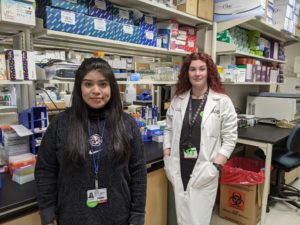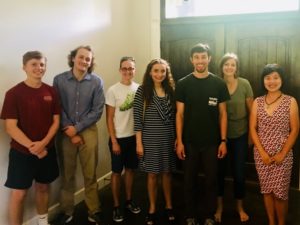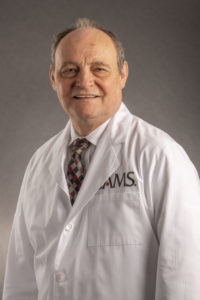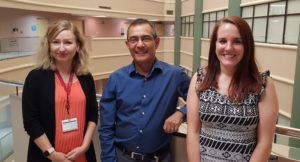Are you a student or postdoc who is uncertain about your career goals? InterSect has job simulations for a wide variety of Ph.D. level scientific career.
Allie Schleiff highlighted by ASPET for work on meclofenamate bioactivation
Congratulations to graduate student Mary “Allie” Schleiff on her selection as the Drug Metabolism and Disposition Highlighted Trainee Author for February 2021. Allie is a Ph.D. student in the laboratory of Dr. Grover Paul Miller. The Drug Metabolism and Disposition article that earned her selection as a Highlighted Trainee Author is titled “Significance of Multiple Bioactivation Pathways for Meclofenamate as Revealed through Modeling and Reaction Kinetics.”
February publications
 Differences in cell death in methionine versus cysteine depletion.
Differences in cell death in methionine versus cysteine depletion.
Tackett Named Deputy Director of UAMS Winthrop P. Rockefeller Cancer Institute
Highly regarded for his research in cancer biomarker discovery, Tackett is a professor in the UAMS College of Medicine Department of Biochemistry and Molecular Biology. He previously served as associate director of basic research for the UAMS Cancer Institute and holds the Scharlau Family Endowed Chair in Cancer Research.
Tackett is principal investigator for the National Institutes of Health (NIH) (R24) National Resource for Quantitative Proteomics and the NIH (P20) Center of Biomedical Research Excellence in systems biology. His National Cancer Institute-funded research program focuses on the use of cutting-edge systems approaches to identify biomarkers and novel pathways of resistance to cancer therapies.
Tackett will work directly with Michael Birrer, M.D., Ph.D., Cancer Institute director, to expand the research and clinical missions of the Cancer Institute.
“Dr. Tackett’s expertise and insightfulness will be a huge benefit to the Cancer Institute as we continue to grow and move toward our goal of National Cancer Institute Designation,” Birrer said.
Giulia Baldini selected to receive Provost’s Innovator Award
Giulia Baldini, M.D., Ph.D., professor in the Department of Biochemistry and Molecular Biology was selected as one of four inaugural recipients of the Provost’s Innovator Awards. Dr. Baldini is studying a potential new way to treat obesity. Her research is focused on naturally occurring genetic mutations of a receptor found in people with obesity. The receptor is expressed in the hypothalamus, where it controls food intake and energy expenditure. Baldini is targeting the receptor using nanoparticles to deliver a substance that induces appropriate signaling to help regulate weight.
Congratulations Dr. Edwards-Azumara!
Congratulations to Andrea Edwards-Azumara who successfully defended her Ph.D. dissertation entitled “Unpaired Regions in G-Quadruplex DNA Regulate “PARP-1 Enzymatic Activation: Implications for a ROS-Directed Transcription and DNA Repair Event” on February 18th. Andrea was a student in the laboratory of Dr. Kevin Raney and is now a post-doctoral fellow at UT Southwestern under the direction of Dr. William Kraus. A summary of her research is below.
G-Quadruplexes are non-B form DNA structures present at regulatory regions in the genome, such as promoters of proto-oncogenes and telomeres. The prominence in such sites suggests G-quadruplexes serve an important regulatory role in the cell. Indeed, oxidized G-quadruplexes found at regulatory sites are regarded as epigenetic elements and are associated with an interlinking of DNA repair and transcription. PARP-1 binds damaged DNA and non-B form DNA, where it covalently modifies repair enzymes or chromatin-associated proteins respectively with poly(ADP-ribose) (PAR). PAR serves as a signal in regulation of transcription, chromatin remodeling, and DNA repair. PARP-1 is known to bind G-quadruplexes with stimulation of enzymatic activity. We show that PARP-1 binds several G-quadruplex structures with nanomolar affinities, but only a subset promote PARP-1 activity. The G-quadruplex forming sequence found in the proto-oncogene c-KIT promoter stimulates enzymatic activity of PARP-1. The loop-forming characteristics of the c-KIT G-quadruplex sequence regulate PARP-1 catalytic activity, whereas eliminating these loop features reduces PARP-1 activity. Oxidized G-quadruplexes that have been suggested to form unique, looped structures stimulate PARP-1 activity. Our results support a functional interaction between PARP-1 and G-quadruplexes. PARP-1 enzymatic activation by G-quadruplexes is dependent on the loop features and the presence of oxidative damage.
Samantha Kendrick featured in Lymphoma Research Foundation magazine
Samantha Kendrick, Ph.D. is featured in on pages 24-25 the quarterly issue of the Lymphoma Research Foundation Pulse magazine for a discussion of her research on diffuse large B-cell lymphoma.

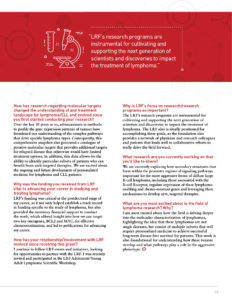
UAMS’s Justin Leung, Ph.D., Receives $792,000 American Cancer Society Grant to Study DNA Repair Mechanisms
“Understanding the molecular processes of DNA repair can help both better diagnose cancer and to progress treatment,” said Leung, an assistant professor in the UAMS College of Medicine Department of Radiation Oncology.
The grant will investigate how signaling molecules on chromatin interact with proteins that repair broken DNA during replication.
“Our DNA encounters damage every day from metabolic byproducts, toxic chemicals and ultraviolet radiation in sunlight. Unrepaired DNA damage can lead to accumulation of mutations, which can cause cancer,” Leung explained. “Our lab aims to understand how cells precisely repair DNA damage at the right place and right time. We study how the DNA damage response is initiated and the mechanism by which DNA repair proteins are brought to the DNA breaks.”
The Research Scholar grant specifically will investigate the regulatory mechanism between a signal on newly replicated DNA and how it brings a specific chromatin modifying enzyme to direct repairs at the site of DNA break at the right time by altering the damaged DNA and proteins landscape.
The new grant follows a $1.9 million funding award in September 2020 from the National Institute of General Medical Sciences supporting Leung’s roadmap project, “Deciphering the Chromatin-based DNA Damage Response Pathway.”
January publications
 The i-Motif as a Molecular Target: More Than a Complementary DNA Secondary Structure.
The i-Motif as a Molecular Target: More Than a Complementary DNA Secondary Structure.

Image by Amy Widner
Infect Immun.
Dr. Tackett presenting for Research Antipasto
Alan Tackett, PhD will host Research and Innovation’s 1st gathering for informal networking, casual mentoring at noon on March 2, 2021. The 1st Tuesday of each month, Research Antipasto’s host will share career experiences, stories, answer questions, advise, astound, and amaze…for 20 – 30 minutes. Just show up, have fun, and get to know others in the research community! Hosts will be posted on the research calendar.


